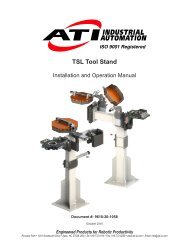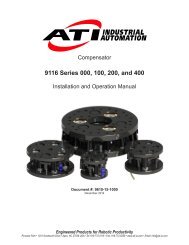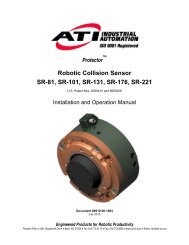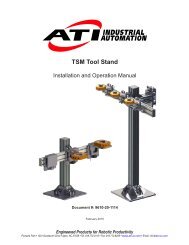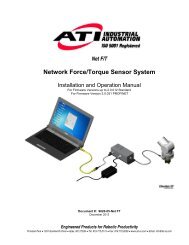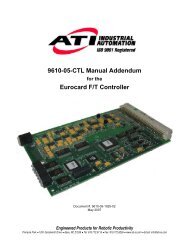Table of Contents
ATI QC-110 Base Tool Changer Modular Manual
ATI QC-110 Base Tool Changer Modular Manual
You also want an ePaper? Increase the reach of your titles
YUMPU automatically turns print PDFs into web optimized ePapers that Google loves.
Quick Change Installation and Operation Manual<br />
Document #9620-20-B-110 Series Base Tool Changer-25<br />
2.4 Tool Interface<br />
The Tool plate is attached to customer’s tooling. The Tool plate is designed with mounting features such as a<br />
recess and/or bolt and dowel holes. These features are used to accurately position and secure the customer’s<br />
tooling. A tool interface plate may be utilized to adapt the Tool plate to customer’s tooling that is not<br />
compatible with the Tool plate mounting features. Custom tool interface plates can be supplied by ATI to<br />
meet customer’s requirements (see Figure 2.2) (Refer to the application drawing).<br />
If the customer chooses to design and build a tool interface plate, the following should be considered:<br />
• The tool interface plate should be designed to include bolt holes for mounting, dowel pins, and a boss<br />
that mates with Tool plate recess for accurate positioning. (The dowel and boss features are important<br />
to prevent rotation)<br />
• The locating boss height should not exceed 0.16” (4 mm).<br />
• The thickness <strong>of</strong> the interface plate must be great enough to provide the necessary thread engagement<br />
for the mounting bolts. Fasteners should be chosen to meet minimum recommended engagement<br />
lengths while not exceeding the maximum available thread depth. Use <strong>of</strong> bolts that are too long can<br />
cause damage to the tool side changer.<br />
• The plate design should take into account clearances required for Tool Changer module attachments<br />
and accessories.<br />
• The tool interface plate should be designed with a hole in its center to allow for manually returning<br />
the locking mechanism to the unlocked position under adverse conditions (i.e. unintended loss <strong>of</strong><br />
power and/or air pressure). The center access hole should be kept small [minimum recommended hole<br />
diameter: 1” (25.4 mm)] to prevent debris from contaminating the locking mechanism while operating<br />
in dirty environments.<br />
2.5 Tool Plate Installation<br />
1. Make sure mounting surface <strong>of</strong> the Tool plate and tool interface plate or customer tooling is clean and<br />
free <strong>of</strong> debris.<br />
2. If required, install the tooling interface plate to the customer tooling, align using the boss or dowel pins<br />
and secure with customer supplied fasteners.<br />
3. Align the dowel pins to the corresponding holes in the Tool plate and secure the Tool plate to the tool<br />
interface plate or customer tooling with customer supplied fasteners. Apply Loctite 242 to threads (see<br />
<strong>Table</strong> 2.1).<br />
NOTICE: If an ATI tool interface plate is used, fasteners to mount the Tool plate to the tool<br />
interface plate may be supplied with the tool interface plate. The fasteners to mount the tool<br />
interface plate or the Tool plate directly to the customer tooling is customer supplied.<br />
4. Connect utilities to the appropriate module and Tool plate connections.<br />
Pinnacle Park • 1031 Goodworth Drive • Apex, NC 27539 • Tel: 919.772.0115 • Fax: 919.772.8259 • www.ati-ia.com • Email: info@ati-ia.com<br />
B-9



